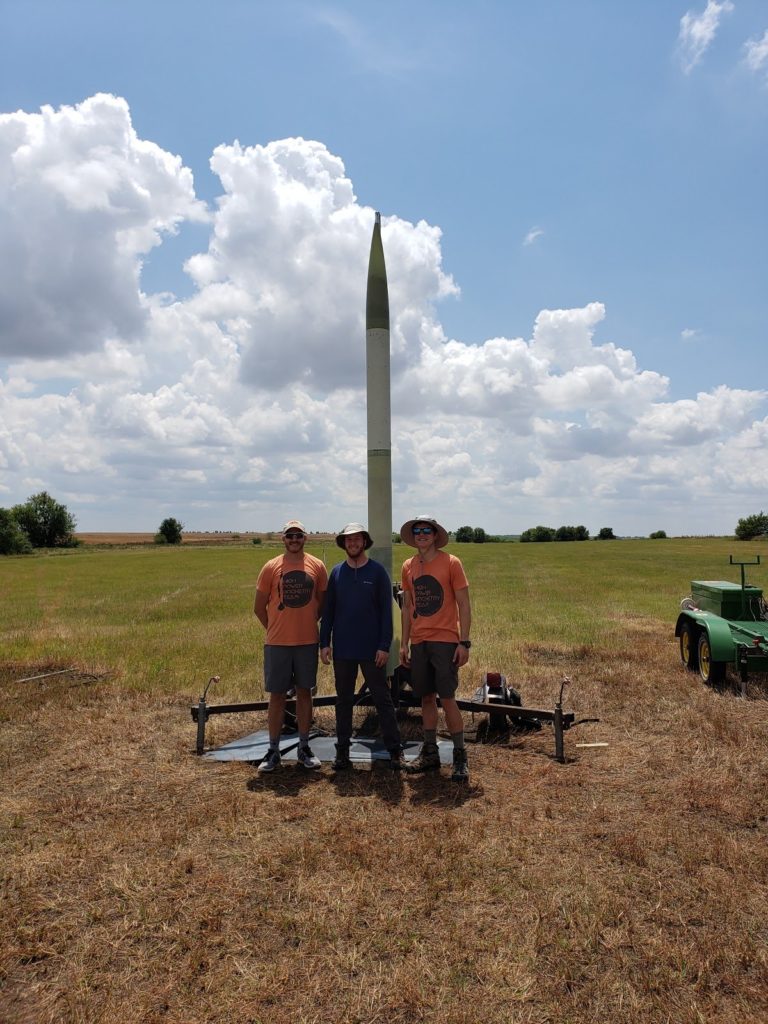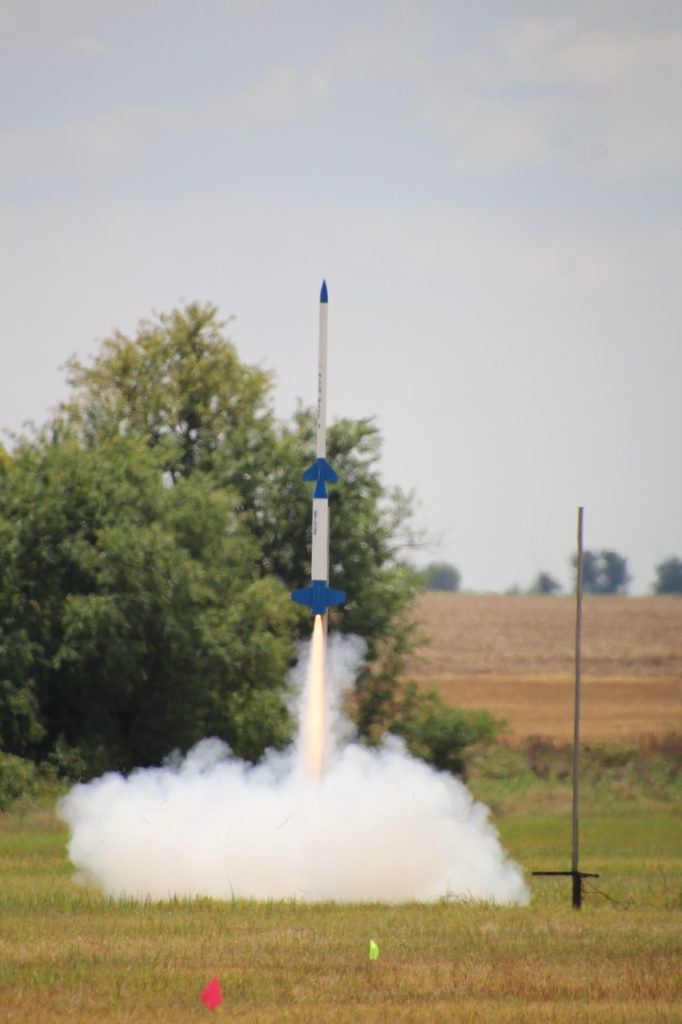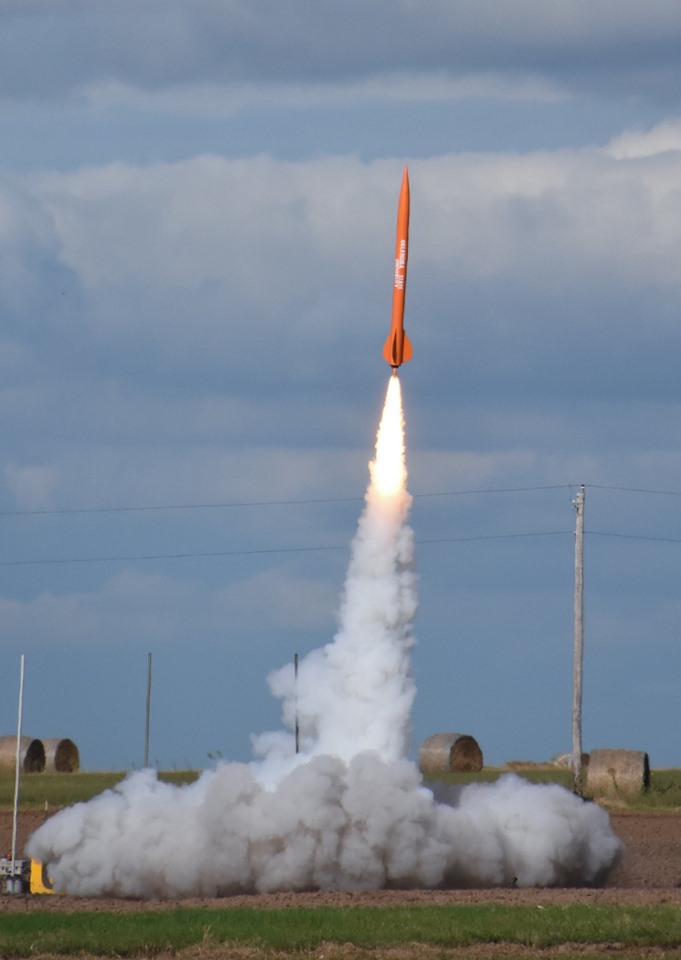5 Years of High-Power Rocketry
7/23/21
At this time 5 years ago, I was building my first high-power kit, a 3″ LOC Iris, for my Level 1 Certification with Tripoli. This post is all about my first 5 years in the high-power rocketry hobby, and discusses mostly my experiences with rocketry at Oklahoma State University.
I’d attended my first HPR launch a few weeks earlier with Tulsa Rocketry, and I was hooked. With this LOC kit, I was using epoxy for the first time, and I bought a Dr. Rockets 38/240 motor hardware set to use with an H148R. The kit came together really well, having been built in my parent’s dining room while I was staying with them in Little Rock for a summer internship in 2016.
The launch in August 2016 was a breezy day in Leonard, OK, and I was incredibly nervous. I got go-fever and sent it up to about 2000ft, at which point the wind carried it away past a tree-line and probably into a woody area. A few friends from school and I spent 4 hours walking through corn fields and woods looking for any sign of it, but no luck. I returned to Stillwater feeling defeated and frustrated, not wanting anything to do with rockets again. I’d lost $300 worth of stuff to a tree, and I was about to start my junior year of college. 2 days later that feeling changed, and I wanted to give it another shot.

Just days before that launch, I began to put into motion the foundation of a rocketry team at Oklahoma State, despite my limited knowledge of HPR. Myself and the other founding members began a team within the OSU AIAA Student Branch (so as to avoid the bureaucracy of starting a new student organization from scratch) and set the goal of competing in the 2017 Spaceport America Cup in New Mexico. We had no idea if it’d be feasible and what kind of obstacles we’d face on the way, but we were inspired by the 2 HPR launches we’d attended thus far, SpaceX’s progress landing boosters, and our driven group of engineering classmates.
Some of us attended Airfest 22 as spectators, marking the first of what would become countless trips to Argonia, KS. It was great to see some giant projects and chat with other university teams and rocketeers. At this launch we first heard of the inaugural Argonia Cup, set to take place the following spring.
We returned to Leonard, OK in October for my Level 1 Certification attempt re-do, and if I succeeded, our first high-power launch of a team-built rocket – a 4″ Madcow DX3 kit. It was a difficult day, but both were successful. I got my L1 on a 4″ Madcow Patriot boosted by an H250G, and our team was on its way into high-power with the team rocket flying well.



In November 2016 we attended the Kloudbuster’s Distant Thunder launch for my Level 2 attempt and another team launch. My L2 was successful on a J350W, and our team launched our first scratch-built kit that also featured our first attempt of dual-deployment recovery. These were also successful, and we felt we’d gained a lot of momentum to carry us through the winter and spring months for competitions.


The 2017 February Fun Fly remains one of the best days of my life. It was a warm, 70-degree day with light winds and sunny skies in mid-February of all months. We launched our first fiberglass rocket, a 4″ scratch-built dual-deploy rocket named after an OSU student who advocated for our club in student government but who tragically passed away that spring semester. Steadfast Steadley, named after Andrew Steadley, flew over 8000ft on a K700W, our first K motor, and our first flight over a mile. We also had close to a dozen successful L1 and L2 certification flights by various members of our team. We left with a long string of successes on the day, and the passion within our team was infectious. People were working until late into the night to push our progress further. It was one of the most exciting times of my life.

Unfortunately, things faltered from there for me personally. I was leading this rocketry team of dozens of students, planning for 2 competitions in the months to come, handling my most difficult engineering classes yet, president of the water polo club, president of the swim club, a section leader in the OSU spirit band, applying to summer internships, and dealing with a failing friendship with my best friend and roommate. All of this made it a challenge to continue onwards, but fortunately the rocketry team members helped move us all along. It was also at this time that I became close with who would become, at the time of this writing, my fiancée, Sam. She was coming to rocket launches too, and that was an exciting bond for us.
We ended up winning the 2017 Argonia Cup, and launched into preparations for the 2017 Spaceport America Cup as the semester wound down. I’d failed to find a summer internship, while almost every other member of the team did secure an internship with one company or another, citing their experience with the rocketry team as a big factor. Myself and one other team member would remain in Stillwater for the summer to finish building our competition rocket, test fly it, and get our presentation and launch materials ready for the week-long trip to New Mexico in June. It was a very tough few months, but ultimately the experience and the competition were a big success. We had a terrible launch, but the team had fun, and it was a good bonding experience for all of us. We were excitedly thinking about returning in 2018.



Although I failed to obtain a summer internship, the rest of the summer was a great opportunity to regroup and get excited for a fresh second year of the rocketry team. I worked for the City of Stillwater mowing parks and doing part-time research for Dr. Rouser, who would ultimately become my grad school advisor. I also studied for and passed the FE exam, so while not a relaxing summer, I felt back to normal once my senior year of college started in August 2017.
I had big plans for Year 2 of the OSU Rocketry Team. We had a new logo, a certification plan for new members, and a roadmap for the 2018 Argonia and Spaceport America Cups. We recruited 48 students to our team and had dozens of certification launches over the year. One of these included my successful Level 3 certification that I’d built over the summer.


At the end of the fall semester, I stepped down to allow new leadership to take over. I would be remaining at OSU for grad school, but I felt the team of undergraduates should be led by an undergraduate student. While I was confident in the student who stepped up, and that he was a good choice at the time, he ultimately didn’t share my level of enthusiasm or motivation to drive the team higher. Overall interest waned quite a bit, and the team lacked the leadership for the 2 upcoming spring competitions. This led to a lot of frustration from the more senior members and resulted in mistakes in rocket preparations and team logistics.
I was participating in the Argonia Cup as part of my senior design project, so I got to design our rocket’s structure, electronics, and build/assemble fiberglass tubes and sheets by hand. We’d previously purchased all our parts from vendors, so it was exciting to make our own composites, as sketchy as they may have looked from the outside. Our rocket-launched quadcopter failed to perform as designed, but the OSU Rocketry Team succeeded with a simple dual-deploy recovery to win for the second year in a row.

Unlike the previous summer, I did manage to find an internship for summer 2018 with none other than the NASA Marshall Space Flight Center in Huntsville, AL. I was in the Propulsion Academy and would still be allowed to attend the Spaceport America Cup for the second year. We had a larger group in attendance with a far more complex rocket. Results May Vary was 12′ fall, weighed over 70lbs, was built using our own hand-rolled fiberglass airframes, contained a functioning airbrake, 360-degree video payload, and launched on an M1939W.
To this day, it’s my favorite rocket we built as a team, and while the launch up was far better than the previous year, the main parachute failed to unfurl, and most of the rocket was destroyed on landing.


In Fall 2018, I began grad school and had less involvement with the university rocketry team activities. I was happy to attend the meetings and mentor where possible, but I intentionally took the backseat, even if it wasn’t going the direction for the team that I had hoped. It was at this time that I began to do more with high-power rocketry as a personal hobby. The launches and competitions with the team kept me plenty busy and fulfilled, so other than certifications, there was no real time, money, or energy for personal launches. That changed at this time when I began to build and test a 4″ Madcow Nike-Tomahawk multistage rocket. I tested the booster and sustainer separately incrementally over the course of a year, and it was a blast. It would take almost a year before a full-successful multistage flight would occur.
2019 was the fourth and so far, my favorite overall year of the high-power rocketry hobby. I was test flying my multistage and one of my grad classes had us beginning with research motors. We made simple potassium nitrate-sorbitol (KNSB) motors to test 3D-printed, water-cooled rocket nozzles, and after the Spring 2019 semester concluded, I tested KNSB motors with graphite nozzles with the intent of a launch of my first research motor that summer. The OSU senior capstone team also won the 3rd Argonia Cup with a lucky dual-deploy recovery.

Summer 2019 was also the first summer I got involved with what would become an on-going collaboration with Honeywell and the National Security Campus in Kansas City, MO. We would build rockets to launch and recover special payloads for them (presumably to test acceleration loads and vibrations during launch). We built two 8-inch diameter rockets for them to launch on M3400 and N5800 motors. The scale of these was super exciting, and our team of just 3 grad students built these in a matter of weeks.
On July 20, 2019, the 50th anniversary of the Apollo 11 moon landing, I launched my first KNSB research motor, and we flew the first large Honeywell-sponsored rocket to support their payloads. A month later, we flew an M3400 and N5800 within 2 hours of one another for them again, and I successfully flew both stages of my multistage project a year in the making, staging a J760 to an H73J to 6000ft.



Over Labor Day weekend 2019 was LDRS 38, hosted by the Kloudbusters in place of Airfest 25. I skipped 2 days of classes, camped out for 6 nights, and flew a bunch of projects. I did another multistage launch, flew my L3 project for the first time in 2 years, and launched another KNSB research motor. We also flew one of the Honeywell rockets without a payload for fun on the extra M1939 we had leftover from Spaceport the year before (the team didn’t attend in 2019).

We rounded out 2019 with another N5800 Honeywell launch, and I flew my first mid-power motors, and a leftover J350W from LDRS. It was such an awesome year, I made a 7-minute video all about it. It was at this time that I stopped maintaining the OSU team’s motor burn log (no one else did), but over 132 motors were fired during those 3 years, burning a total of 180,000N-s. With all the Honeywell projects since, this figure is surely over 350,000N-s by now.
2020 was a much slower year due to the COVID-19 pandemic. I defended my master’s thesis on 3D-printed, water-cooled rocket nozzles, and completed my time at OSU. My job with Textron Aviation was postponed from June to September, so I got to stick around Stillwater for another summer to help with more Honeywell launches and a RATO project. We unfortunately CATO’d an N5800, but Honeywell nevertheless wanted to continue with more launches to come. Airfest 26 still took place, and I flew my first clustered rocket, igniting (3) F42T’s on the pad.
Since I was now living in Wichita, the launches in Argonia were even more accessible to attend, and the OSU team continued to come as well. It was nice to keep in touch, and I even got to pitch in and help with more Honeywell launches (including OSU’s first O motor, an O3400) and certification attempts. Being away from the OSU team and its abundant parachutes, altimeters, tools, and motor hardware, I’ve been building and flying much smaller projects on mid-power and L1 motors primarily. It’s still good fun, and I’m happy the smaller projects are as fulfilling as they are, since I’d just finished building and flying multiple M and N projects for Honeywell the past couple years.
In 2021, my 5th year with Tripoli, I’ve dabbled in soldering my own altimeters with several Eggtimer kits. I have some bigger projects in the works, but most of my funds have been going towards my own motor hardware, parachutes, altimeters, and motors for these smaller projects. Younger students from OSU keep me in the loop with their rocketry efforts, which means so much to me. Dr. Rouser’s research group has successfully fired 54mm research motors using composite propellant formulations (this was my dream during my time at OSU; I wanted to mix and cast composite propellant more than anything else), and in June, the Honeywell project research group of 6 students trekked all the way out to the China Lake Naval Air Weapons Station in California to continue launches for Honeywell. Those two events make me immensely proud. While I wish I could be participating with them and taking part, I like to think I had a role building that foundation for them. As a founding member of an organization like that, what more can I ask for?
I wanted to use this post as a summary of my 5 years in high-power. I didn’t quite intend to go into such detail, but I’m glad I did. I can’t imagine the next 5 years being nearly as exciting, but as long as it brings me enjoyment, that’s all I want. I hope the OSU team can continue to grow and develop. During that Fall 2017 semester, I had dreams of composite research motors, starting a liquid engine team, and attempting a quarter-space shot. Other universities across the country were working on those, why not us? While those dreams weren’t realized during my time there, maybe they will be in the coming years by the students to come. As long as I’m nearby and they keep coming to the Rocket Pasture, I’ll be here, excited to see what they have to fly. I burned 24,000N-s of impulse in these 5 years, and I have more personal projects in the works. I hope to launch the M1419 I was gifted during my time at NASA (my mentor was in HPR before he had a daughter and felt giving the motor on would do me more good than him) and build a high-altitude project to 30,000ft in 2022. Thanks for reading!


